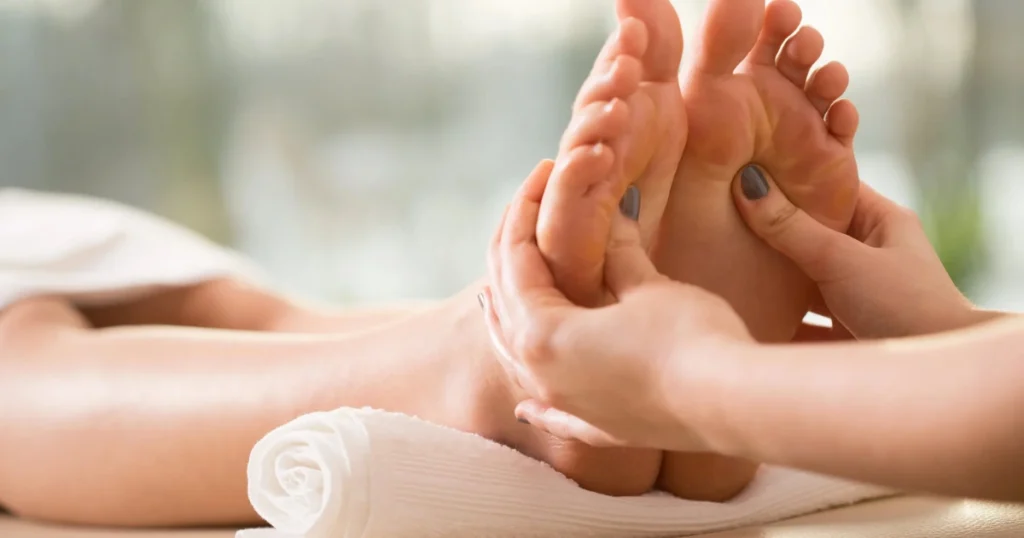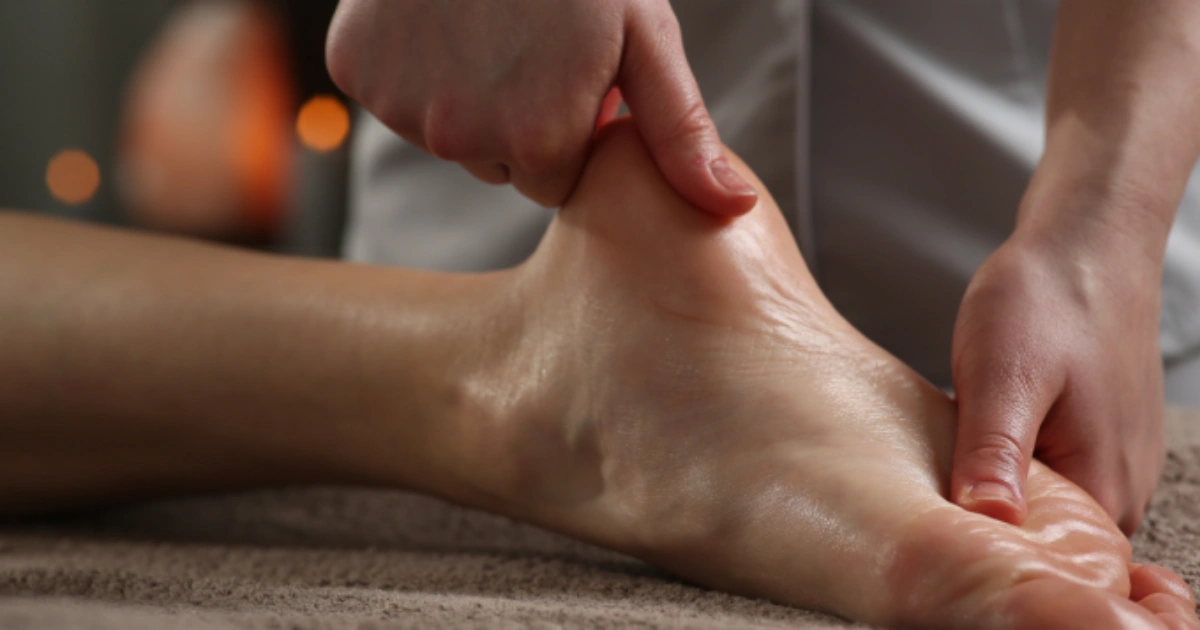In our busy lives, simple and natural ways to restore balance and well-being can make a real difference. One of the most underrated but powerful practices is foot reflexology—a gentle technique that taps into pressure points on the feet to help the entire body reset, relax, and heal.
At its core, foot reflexology is a wellness method that requires no medication, no machines, and no expensive appointments. You just need your hands, the right mindset, and a bit of knowledge. And when paired with other natural self-care practices like those shared at Secrets of the Green Garden, you can create a powerful daily wellness ritual that transforms your health from the ground up.
Whether you’re looking to relieve stress, improve your sleep, reduce chronic pain, or simply reconnect with your body, this guide will walk you through everything you need to know.
What Is Foot Reflexology?
Foot reflexology is a natural therapy based on the idea that certain areas of the foot correspond to specific organs and systems in the body. When you apply gentle pressure to these reflex zones, it stimulates the related body parts and promotes relaxation, healing, and balance.
The technique has deep roots in Traditional Chinese Medicine and Ayurveda, where the feet are considered a mirror of the body. Each foot contains over 7,000 nerve endings connected to your nervous system, meaning a few intentional presses can communicate directly with your inner workings.
This isn’t just theory—many holistic gardeners and natural health enthusiasts are rediscovering the benefits of self-healing, as you’ll find in related guides like this one on natural herbs for better sleep.

Key Benefits of Foot Reflexology 🌟
Reflexology isn’t just a feel-good massage. Regular sessions can offer a wide range of benefits for both physical and emotional health:
- Reduces stress and calms the nervous system
- Improves sleep quality and helps regulate melatonin
- Eases chronic pain such as backaches, migraines, and menstrual cramps
- Stimulates blood circulation and lymphatic flow
- Supports immune system function and detoxification
- Balances hormones and soothes mood swings
- Brings immediate feelings of grounding and relaxation
Many people use reflexology alongside wellness practices like growing lavender in their garden or making herbal foot soaks—a perfect combo for full-body calm.
How to Practice Reflexology at Home
You don’t need to be a professional therapist to enjoy the benefits of reflexology. Here’s a simple step-by-step method to apply reflexology to yourself or a loved one:
1️⃣ Wash the feet with warm water
Clean, warm feet are more receptive to touch and make the experience more relaxing.
2️⃣ Set the scene
Create a peaceful atmosphere—dim the lights, play soothing music, and add calming scents like lavender or eucalyptus.
3️⃣ Choose a natural massage oil
Coconut, sweet almond, or sunflower oil are great options. You can also add a drop of essential oil for extra relaxation.
4️⃣ Warm up the feet
Rub the soles, heels, and tops of the feet with circular movements using your thumbs and palms.
5️⃣ Use a foot reflexology chart
Locate the zones on the feet that correspond to the body part you want to support (e.g., toes for head/sinuses, arch for digestive organs, heel for lower back).
6️⃣ Apply gentle pressure
Press each point with a circular motion or a slow thumb press. Hold for 5 to 10 seconds. Don’t press too hard—it should never hurt.
7️⃣ Stretch the toes and ankles
Rotate the feet and gently stretch the toes to enhance circulation.
8️⃣ Wrap the feet afterward
Cover the feet with a warm towel or wear soft cotton socks to help lock in the benefits.
Best Natural Oils for Reflexology 🌱
The right oil can enhance your reflexology session. Here are some top choices and when to use them:
🥥 Coconut oil – Light, cooling, and antibacterial. Great for summer or humid climates.
🌰 Sweet almond oil – Softens dry skin and glides well. Ideal for sensitive skin.
🌻 Sunflower oil – Rich in vitamin E, quick to absorb, and perfect for daily use.
🪔 Sesame oil – Warming and grounding. Use during colder months.
🌸 Lavender essential oil – Calming and soothing. A few drops in your base oil can help with sleep and relaxation.
Seasonal Tips for Reflexology Practice
Adapting your reflexology sessions to the seasons makes the experience even more effective.
❄️ Winter
Use warming oils like sesame. Keep the room cozy and wrap your feet well after the session.
☀️ Summer
Choose cooling oils like coconut. Let your feet breathe afterward.
🌧️ Humid climates
Ensure feet are dry before starting. Moisture can lead to fungal growth.
🏜️ Dry climates
Hydrate your skin beforehand and use richer oils for extra nourishment.
Tools and Materials Checklist 🧴🧦🗺️
Here’s what you’ll need to create your own reflexology ritual:
🧼 Mild soap or foot scrub
🪔 Natural base oil (coconut, almond, sunflower, etc.)
🌱 Essential oil (optional)
🗺️ Foot reflexology chart
🧦 Cotton socks or soft towel
🧽 Warm cloth for cleanup
Common Mistakes to Avoid
Even with the best intentions, certain habits can reduce the benefits of reflexology. Watch out for these:
❌ Using too much pressure
It’s about stimulation, not pain. Go gently.
❌ Guessing the zones
Use a reliable foot chart to find the correct reflex points.
❌ Rushing the session
A proper session takes at least 15 minutes. Don’t rush the process.
❌ Skipping preparation
Cold rooms and unwashed feet interfere with the experience.
❌ Using synthetic products
Avoid lotions with artificial fragrances and chemicals.
Internal Link Tip 🌼
If you’re growing your own herbs or looking for other ways to detox naturally, consider reading this guide on homemade herbal detox remedies. These herbal supports go beautifully with reflexology for whole-body wellness.
Frequently Asked Questions (FAQs)
Can reflexology replace medical treatment?
No. Reflexology is a complementary practice, not a substitute for medical care.
Is it safe to do reflexology every day?
Yes, but 2–3 times a week is ideal for lasting benefits.
Can children or seniors benefit from reflexology?
Absolutely—just use a lighter touch and avoid strong oils.
What if I feel pain during the session?
Pain is a signal to ease up. Reflexology should never hurt.
How long before I see results?
Some benefits like relaxation are immediate. Others, like sleep improvement, may take a few sessions.
Conclusion: Put Wellness at Your Feet 🌿
Foot reflexology is a beautiful way to reconnect with your body, soothe your nervous system, and create a deeper sense of balance in your life. It takes just 15 to 20 minutes and can be done anywhere—before bed, during a quiet morning, or as part of your weekly self-care ritual.
Try it a few times a week and notice the difference in your sleep, mood, and energy. And for more ways to naturally support your health, be sure to explore the wellness tips at Secrets of the Green Garden.
Have you tried foot reflexology? What benefits have you experienced?
Drop your story in the comments and share this article with someone who could use a little healing at their feet. 💚🦶


https://t.me/s/Beefcasino_officials